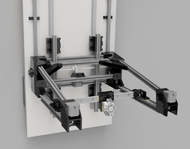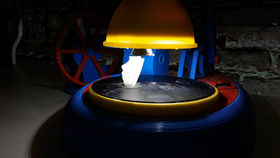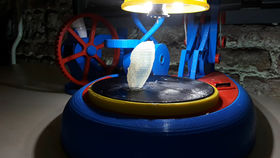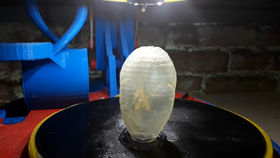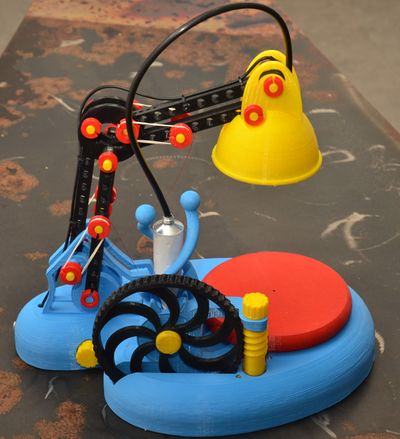CoreC
The CoreC is a 3D printer designed for the medium/large manufacturing that operates within a network for a just-in-time and local production, managed by a remote SW able to optimize production by guessing market trends. FDM is the predominant technology in 3D printer solutions, thanks to its cost/benefit ratio. The goal of our the project is to bring the advantages of FDM technology to its next level, from an amateur stage, in to the production of goods for the entire community.
Release status: working
| Description | Fused Deposition Material
|
| License | CC BY-NC-ND 4.0
|
| Author | |
| Contributors | |
| Based-on | |
| Categories | 3D Printer
|
| CAD Models | Yes
|
| External Link | see below
|
Contents
Design
The machine has been designed to help the optimization of the company spaces, exploiting the verticality of the machine. The CoreC system is assembled inside a 19" rack server and can move over the entire height of the cabinet. Its design is strong and robust as an industrial machine, this is the reason for choosing a server rack, so that it can be both slim and light in its components. The printer structure permits a rapid change of the printing module, thanks to the fusion of all mechanical and electronic component in one unique “core”, so its possible to rapidly unmount the module for the backup substitution.
Capabilities
CoreC is an FDM 3D printer designed for mid-scale production that operates within a real-time cloud system for production optimization. Main features:
- The management SW programs the machines to provide a targeted production of items by lowering the unsold while maintaining a high number of varieties.
- The software works interdependently with CoreC devices, arranged according to a decentralized model within strategic hubs inside the retail network.
- Modular system assembled into a server rack.
- The structure is designed to place from 1 up to 9 interchangeable 400x400mm printing plates, on a Z axis of 1800 mm.
- The printer provides sequential production, extruding on differents plates. Once a printing plate is completed, the printer unit controlled by the SW moves on to the next one, granting a continuous and flexible flow of production.
- The software communicates with the printer to provide a management plan that takes in account the needs of the market in real time and optimizes the printing plates with respect to the shape, time and size of the items to be produced.
- The modular system allows to choose the construction volume according to the production requirements.
Frame Material
The printer composed by two main elements:
- Server Rack: 19” rack contains the Z axis movement the power unit and hosts two CoreC modules: one core is functional and the other is for backup purpose
- CoreC module: Made of printed plastic and Aluminium 2020 extrusions.
The main properties:
- Rheological: melt elasticity lower than that of olefins.
- Mechanical: they vary from those of an amorphous polymer to those of a semi-crystalline polymer;
intermediate properties to those of PET and polystyrene. The glass transition temperature is higher than the room temperature; transparent materials are obtained.
- Biodegradability: as a product it is not biodegradable; it becomes so after hydrolysis at a temperature
greater than 60 C and humidity greater than 20%. Plastics of common use have an average life that can vary from 100 up to even 1000 years. PLA, on the other hand, has much shorter biodegradation times: depending on the environments in which it is abandoned, it has an average life span ranging from 1 to 4 years.
The physical characteristics:
- Density: 1,210 - 1,430 g.cm-3
- Melting range: 150 - 160 °C
- Glass transition: 60 - 65 °C
- Elastic modulus: 2.7 - 16 MPa
PLA is the easiest material to print, with a minimum cold shrinkage, with very few adhesion problems on an aluminum plate (in any case it is necessary an adhesive layer) and above all safe for the operator's health. Degradation fumes in temperature are not toxic, as in the case of using ABS. 2.5 Printable materials
Printable material
The real innovation is the material that is deposited by the printer and its deposition technique. Like a FDM 3D printer there is a stepper motor that pushes the viscous material towards the nozzle, but there is no hot melt. The printer extrudes a polymer resin that hardens with visible white light. For this reason when the machine does not print it can be used as a table lamp. The properties of photo-cross linkable resins have improved significantly in the last ten years: different types of materials have appeared on the market with properties optimized for specific applications and different types of 3D printing. The photocuring of these photo-active materials does not depend only on their chemical composition, but also on the irradiation power and time. The most widely used monomers are multifunctional acrylates that polymerize very quickly and can give rise to different materials by introducing chemical modifications in the precursor structure. Typically, a photo-cross linking formulation consists of two main components: a photo initiator that absorbs incident light and gives rise to two radical fragments and a monomer containing at least two unsaturated bonds, which may originate the polymeric network. Also in the last ten years, many researchers have exploited their efforts in the development of efficient photo-initiators able to generate radicals under the action of UV radiation.
These photo-initiators absorb the incident radiation which leads them to an excited electronic state from which the reactive species is produced. Therefore, a high and suitable absorption coefficient by the photo-initiator is fundamental, as well as a suitable absorption spectral range. The resins used for the most common 3D pens have been formulated with a composition free of toxic substances and, consequently, not dangerous for use by children under adult supervision.
The naturally occurring oxygen in the air impedes the chemical reaction that allows the molecules to bind to each other forming a chain of polymers. This is why the most superficial part of the resins is often thick and sticky. The resin has been formulated so as not to be sticky on the surface and to be cross-linked by irradiation of cold white light LEDs. The power chosen for irradiation is 3W, which corresponds to the most used power size in LED light bulbs for desk lamps.
The q3d can print 110x110x120 mm sized objects, created using virtual reality modeling techniques.
| Specifications | |
|---|---|
| Controller Electronics | Duet2 Wifi Board |
| Printing material | FDM printing filament up to 300°C |
| Printing Size (mm) | 400X*400Y*1800Z |
| Motors | 4 x NEMA 17 Stepper |
| Frame Material | PETG and Aluminium |
| Sensors | IR bed sensor, runout filament, power loss sensor, |
